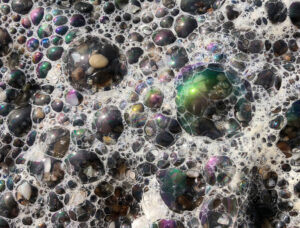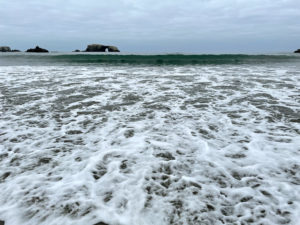How do seaweeds, such as sea palms, stay in place while being battered by powerful waves?” -Alan, Berkeley
At McClures Beach on the north end of the Point Reyes peninsula there’s a large rock at the edge of the ocean. From atop that rock, you can peer over the edge and watch the powerful waves—which have traveled unimpeded several thousand miles across the North Pacific—pound against the hard granite. But growing on that battered rock face, not only surviving but thriving, is a type of marine algae called sea palms. As the waves smack over them the sea palms bend completely over and then bounce right back up into the air. “What? Is that the best you can do?” they seem to be saying to the raging surf.
Postelsia palmaeformis do indeed look like palms and it is no coincidence that the profiles are similar. Land palms can endure hurricane/typhoon winds of hundreds of miles per hour. Both types of organisms have evolved the perfect shape to take the toughest conditions Mama Nature can throw at them. Such a metaphor! When life seems overwhelming, don’t resist—be flexible! Bounce back and get ready for the next big wave or titanic wind.
But sea palms are ancestral to and much more primitive than land palms. Sea palms are a kind of brown algae, and unlike land plants that get nutrients through their roots, they take in nutrients and gases directly from the ocean water through their cell walls.
The structure that anchors the sea palm to the substrate may look like a root system, but it exists solely to keep the seaweed attached to the rock. Hence its common name, holdfast. In fact, if you find a sea palm washed up on the beach, check out the holdfast: You’re likely to find that it is still holding on to a piece of the rock. The rock often breaks before the holdfast does!
So how do they gain such a tight hold in this dynamic environment? Sea palms, like most algae, reproduce by spores, and these tiny spores settle into nooks and crannies in the irregular rock surface. There they secrete a kind of glue made up of polysaccharides (sticky sugars) that ensure a tight fastening. Fingerlike appendages called haptera grow to become the large holdfast, which further moors the seaweed against the force of the waves.
The other structural advantage of the sea palm is its tough, thick, hollow but flexible stem, or stipe, which allows it to stand up in the air. Sea palms are the only marine algae that do not require water to support their stipes.
The main competitor for space in these extremely exposed but nutrient-rich habitats are mussels, but the sea palms often win out. The fiercest surges often scour rocks of mussels, while sea palms flourish in wave-battered rocks by taking advantage of the weird little cracks and crevices the world offers. Adaptation and flexibility win again.





